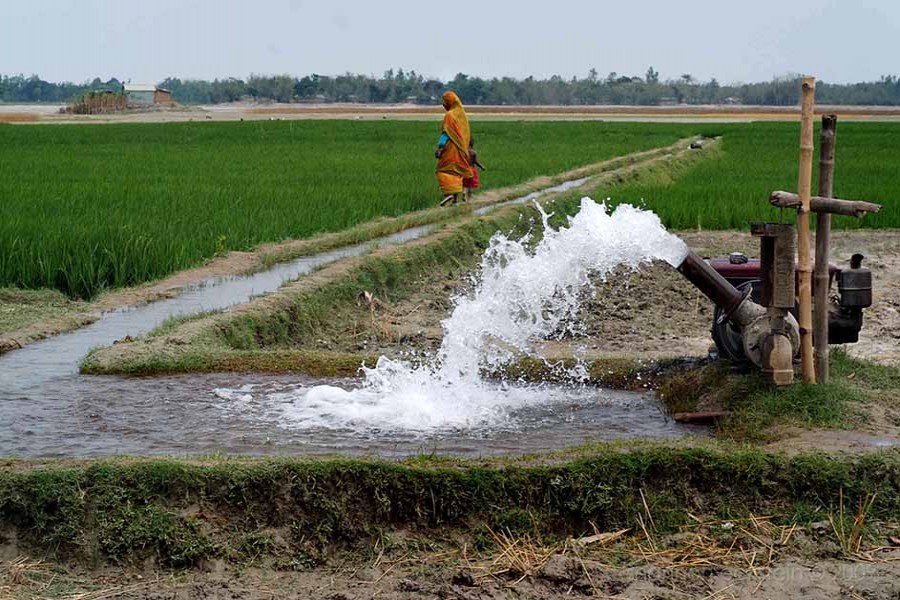Average rainfall in Bangladesh is reported to be more than 2,000 mm per year with more than three-fourths occurring from June to September. Thus, excessive water logging in the rainy season and inadequate moisture in soil in the dry season (January to April) adversely affect the production of the staple crop -- paddy. In a large number of villages, substantial variations in topography of the arable lands exists, and quite a few villages have both high and very low land side by side. The implication of this is that, even if topography tells upon the adoption of Modern Varieties (MVs) of paddy, at least some land will be found suitable for cultivation of these varieties. Again, where the farmer operates a number of plots at different points, and at different elevations within the same village, there is a good chance that at least one of his plots could be suitable for growing MVs. This makes the distinction as per adopters and non-adopters difficult. By and large, an unfavourable production environment for MVs is said to exist either in high land (inadequate soil moisture) or in very low land (excessive water logging).
For all seasons, the rate of adoption of MVs is the highest on medium high land, followed by high land, and very low land. During the dry season, adoption is the highest on very low land and medium high land, but lowest on high lands. The reasons are not far to seek. During the dry season, extremely low-lying villages have relatively easy access to surface water from rivers and canals, while medium high villages have access to ground water. This makes the incidence of irrigation quite costly. Adoption of MVs during wet season, however, varies with the elevation of land. By and large, availability of water sometimes appears as woes for farmers. Water also appears as woes on another count. Bangladesh has a long coastal area that suffers from salt water intrusion, particularly in dry season, when salt is deposited in the soil in some areas. MVs available in Bangladesh are not sufficiently tolerant of salinity and, hence, the coastal areas are deprived of the opportunities of growing these crops.
Since the very inception of mechanised irrigation in Bangladesh - mostly driven by the dry-season - a state entity like Bangladesh Agricultural Development Corporation (BADC) stepped in for supplying seed and water to farmers. BADC used to buy deep tube wells (DTWs) with a capacity of watering 12-15 hectares of land and rent these out to village cooperatives. Besides, low lift pumps (LLPs) were also rented out for irrigation by using surface water. Then came the phase of selling equipment with provision for credit that large land owners took advantage of. But very soon it appeared that, in the face of high demand for water, owners of the equipment began to charge excessive rates for water and, within few years, they emerged as "water-lords". On the other hand, possibly to help these groups, installation of shallow tube wells (STWs) within a fixed radius was banned by the government.
Since the mid-1980s, the government implemented an epoch-making policy reform in the marketing of agricultural inputs. The policy aimed at reducing the role of the government and, at the same time, lubricating the role of the private sector in the arena of irrigation. And to this effect, the government (a) removed the ban on private-sector investment for minor irrigation equipment; (b) encouraged the private sector to import agricultural machinery; (c) reduced import duties on pumps and other accessories, and (d) lifted the restrictions on standardisation of irrigation equipment. Bangladesh experienced a rapid expansion of irrigation facilities after those policy changes. In the subsequent periods after liberalisation of equipment markets, considerable investment has been made in developing ground water irrigation. As farm holdings are scattered, the owners of the equipment can also command operated lands outside the command area. As a result, especially in dry season, a market developed in rural areas to exchange water for MV paddy (boro). We have named it as "water-market". As of now, 1.6 -2.0 million shallow machines are operating and all of them are under private ownership. Under different contractual arrangements, the services of the wells are sold in the "water-market".
At the same time, and as revealed by different studies, a revolutionary change has also taken place in the mode of payments of water price. Initially, one-fourth of the harvested crop was to be surrendered in exchange for water, as and when needed. Later, a system of cash rental, per hectare per season, was introduced. And recently, a system of water charge per hour of the machine has been developed in many places. The hourly rent varies depending on who bears the cost of fuel. With the development of the hourly rate, reportedly, water is being used more efficiently, and the unit cost of irrigation has begun to decline. It may be mentioned here that the machines used in the dry season are also being used for supplementary irrigation in rainy season rice crop (amon), particularly during the time of inadequate rainfall. This helped avert the impact of drought on amon crop. In some places, the owners of the STWs or LLPs are renting out (or using for themselves) equipments for running country boats in rainy season and, thus, opening up another window of non-farm income generation. In some places again, uses of machines in transport are also reported. Thus, these are used not only for irrigation but also for earning income from non-farm activities.
Abdul Bayes is a former
Professor of Economics, Jahangirnagar University.


